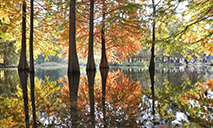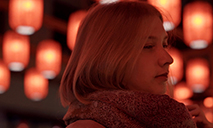At Beijing 2022, ski jumpers will be “jumping into” the Great Wall

A photo taken on December 19, 2021, shows the National Ski Jumping Center in Zhangjiakou competition zone of Beijing 2022 Winter Olympcis, Hebei Province, China. (Photo/ Xinhua)
The National Ski Jumping Center, or the ‘Snow Ruyi,’ is in its busy snowmaking days now, getting ready for the forthcoming Beijing 2022 Winter Olympics. Tucked away in the tranquil valleys of the Zhangjiakou competition zone, the ski jump will be welcoming guests with its shape of ‘Ruyi,’ which is a kind of auspicious Chinese ornament.
Maybe a little pointer in advance to make the ski jumping event more interesting when you watch it in three months: after the ski jumpers set off from the metal bar above and race down the world’s longest ramp, they will find themselves ‘flying into’ the Great Wall, a special feature at the National Ski Jumping Center that was created by its designers who gave some thought as to how to best inspire the athletes during their performances.
Special view for 0.3 seconds
Designing a winter sports venue is a coordinated multi-disciplinary process, involving knowledge of geotechnics, geologic hazards, meteorology, and so many more fields. Designers also have to be knowledgeable about the events they are planning for.
Well, as one practitioner put it, ski jumping is nothing less than a psychological game: “10% physical, 90% mental,” as was quoted in Eddie the Eagle, a biopic on Britain’s most famous ski jumper Michael Edwards. “It takes a lot of guts to go to the top, but it takes 100 times more courage to jump off the end.” While the degree of psychological challenge may vary among jumpers, the cringing feelings are surely there.
The discipline of psychology tells us that, apart from being hyper-focused on their immediate performance, athletes will have about 0.3 seconds to observe their surroundings before setting off from their mark, which can have a huge effect on the athletes’ underlying mood before jumping.
For the past few Winter Olympics, one of the most popular ski jumping venues among athletes was the one in Whistler, British Columbia, Canada.“Because you have the aboriginal sacred mountains in front of the ski jumpers. So when taking this 0.3 seconds' glimpse, there's always a drive in the ski jumpers to fly towards those mountains," said Zhang Li during a lecture on the Winter Olympics at Tsinghua University. Zhang is the dean and a professor at the School of Architecture, Tsinghua University, who is also serving as the Chief Design Officer of the Zhangjiakou cluster and Big Air Shougang venues for the Beijing 2022 Winter Olympics.
To provide a better view for the jumpers, the venue’s designers entered into discussions with professionals from the International Ski Federation (FIS) and decided to rotate the ski jumping hill by 20 degrees anticlockwise. Instead of a knoll, now the hill is facing a valley with the ruins of the Great Wall zigzagging on top.
Hopefully, such a specially designed environment will also provide a drive for the athletes competing in Beijing. By then, the athletes will be told that “if you are lucky, you’ll be ‘jumping into’ the Great Wall.”
Sustainability with human touches
It is a reawakening of cultural consciousness and a milestone to be able to present Chinese architectural designs to the world, said Wang Chong from the design team during an interview, who highlighted that the Olympic venue combines cultural elements, visual effects, and functional features together into one whole package.
“Ruyi,” a homophone for “as you wish” or “as you desire” in Chinese, is also revered by the Chinese people for its allusive symbol of good luck, and can be made from a variety of materials, such as jade, emeralds, gold and pearls. Now, this cultural icon has been symbolically blended into the curve of the Olympic ski jump made of steel, offering up a futuristic and eye-catching landmark.
One fact to remember is that such ski jumps are designed for “superman,” as Zhang put it, partly because of the many long years needed to acquire such top-level athletic skills and the comparatively small number of active ski jumpers around the world.
When implementing a design for particular purposes, another challenge is to “program all of those (superman) things into what speaks to the bodies of common man.” One of the solutions the design team has proffered is to have at the end of the ramp a small football field, where multiple activities like ceremonies and music festivals can take place.
“The usual way for designing a ski jump stadium is to have a reverse slope (at the end of the hill), so that the athletes can slow down much faster, and so you need a much smaller stadium; but when you do that, the stadium can only be used for ski jumping events,” he explained.
Attention to human factors could bring people’s experience to a new level and prolong the life of the venue. “Whether it will be proven we still have to wait and see, but at least we have tried,” said Zhang.
Photos
Related Stories
- All-factor tests conducted at Beijing 2022 Olympic and Paralympic Village
- China to issue commemorative coins for Beijing 2022 Winter Paralympics
- Beijing 2022 encourages winter sports industry in Baiyin
- Beijing 2022 venues to harness technology for carbon neutral Games
- Commentary: Beijing Winter Olympics to unite the world
Copyright © 2021 People's Daily Online. All Rights Reserved.










